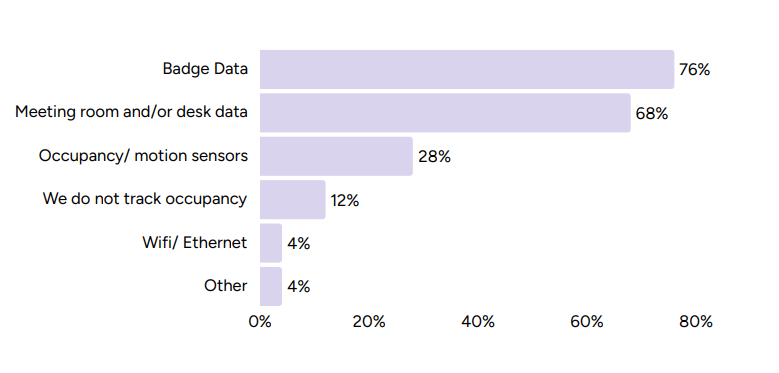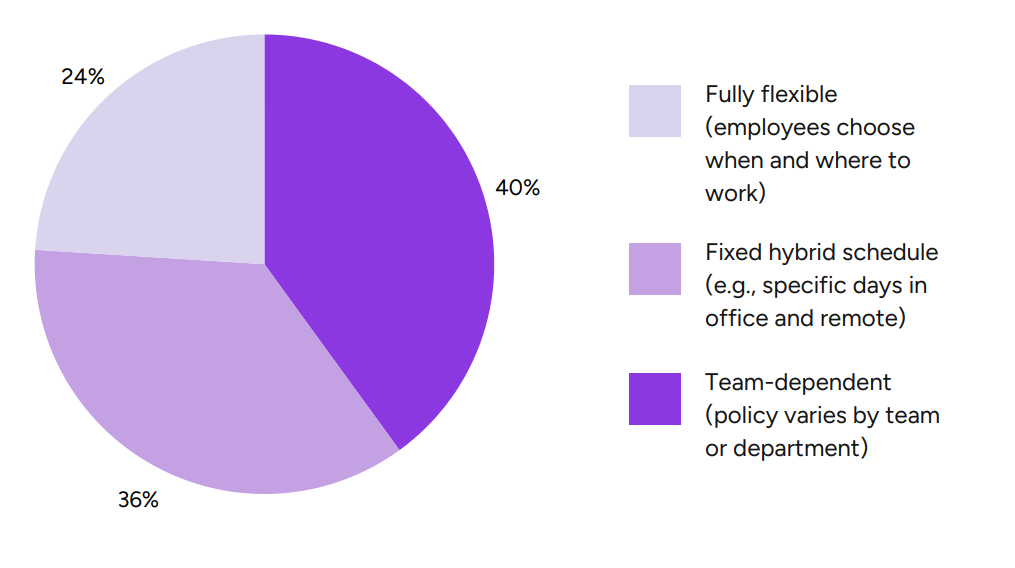Occupancy monitoring enables employers to optimize workplaces based on how they’re used. By tracking the number of people in a building, on a floor, or reserving shared spaces throughout the workweek, employers can determine whether they have the right amount and types of space for employees to be productive and satisfied.
Organizations can also use occupancy monitoring in the workplace to measure the effect of changes in company policy, such as adjustments to hybrid work schedules or return-to-office initiatives. As real estate leaders consider which locations to renew, close, consolidate, or open, occupancy monitoring plays a key role in right-sizing the organization’s portfolio, ensuring that real estate decisions align with company goals and operations.
But if you haven’t already implemented occupancy monitoring in your organization, it may seem hard to justify the expense of occupancy tracking technology like sensors or complex custom software.
In an enterprise occupancy tracking study we conducted, 48% of respondents said the most significant barrier to their organization’s adoption of occupancy tracking was the initial technology investment, and an additional 42% indicated that maintenance and upgrade costs was at least a “very significant” barrier. At the same time, they identified several use cases for occupancy tracking that had significant alignment with their business needs.
So, how should workplace leaders who want the benefits of occupancy monitoring persuade stakeholders to invest in the necessary tools and technologies? While every organization needs to determine the type of technology and level of investment that makes sense for their specific business goals, this article will outline the business case for occupancy monitoring in the workplace.
But first, it’s worth clarifying: occupancy monitoring probably costs a lot less than you think.
Occupancy monitoring doesn’t have to be costly
Many conversations around occupancy monitoring focus on the precise utilization data organizations can collect from sensors like Light Detection and Ranging (LiDaR) strips, blurred vision cameras, and desk sensors. These specialized devices let you accurately track particular spaces within a building whether they’re assigned or unassigned, reservable or non-reservable.
But sensors aren’t the only way to implement occupancy monitoring in the workplace—in fact, in our occupancy tracking study, just 28% of large enterprises used them.
Many office-based organizations use badge scanning systems at least for access control to employee-only spaces. This was by far the most common occupancy tracking technology used by enterprises, with 76% of respondents indicating that their organization used it, and 20% saying that badge data was their only form of occupancy tracking.

Badge data certainly isn’t as precise as space utilization sensors, but for many organizations, it gives enough information to start reaping the benefits of occupancy tracking—especially when paired with another form of easily accessible data, like desk bookings and meeting room reservations. In many cases, the challenge for organizations isn’t collecting more occupancy data. It’s using their data more effectively. Whatever data you collect, even if it’s only badge data, you need a comprehensive occupancy analytics solution and the ability to access occupancy insights in space management workflows.
But whether you’re just looking to get started with data you already have or you’re investing in more robust technology, here’s how to make the business case for occupancy monitoring.
The business case for occupancy monitoring technology
When occupancy monitoring leads to action (as it should), it reduces costs and risks while making an organization’s operations more effective. Companies that leverage occupancy data to make decisions about their workplace achieve better outcomes because the decisions are based on demand for space and actual patterns in utilization.
Lower real estate costs
Occupancy monitoring helps organizations avoid paying for space they aren’t using. The more precise the data, the more precise their real estate decisions can be. But even with badge data alone, companies can analyze how much space they have in relation to the typical number of people who use it.
How close do the average and peak occupancy rates come to the space’s max capacity? How many workstations do they actually need? These types of questions should inform a company’s decisions to renew, close, consolidate, and open locations. And with occupancy monitoring, they can.
When a company wants to reduce its square footage and lower real estate costs, occupancy monitoring helps them understand how much real estate they need, so they can consider their best options for reducing it. Additionally, when the company needs to find additional space to grow, occupancy monitoring helps them identify buildings where they may already have the room they need, so they can avoid acquiring new space.
Better hybrid work/RTO policies
Hybrid work policies and return-to-office mandates challenge companies to balance their supply of space with demand. Every workplace has a fixed amount of space, and as you adjust the number of people sharing that space on a given day or at a given time, that impacts their access to these shared office resources.
Employers need to fine-tune their policies to align with utilization, keeping peak occupancy low, and ideally distributing occupancy levels throughout the work week. If they’re actively monitoring the number of people in the office, they can make adjustments based on numbers, not just what they happen to observe or what they hear from employee feedback.

Increased productivity
When employees can’t access the workstations, meeting rooms, and other spaces and assets they need to work, it directly impacts their productivity. The more time people spend waiting for resources to be available, the less they can accomplish. And if employers wait for a threshold of employees to complain about a problem before they address it, their workplaces are going to be full of inefficiencies people simply haven’t reported yet.
With occupancy monitoring, employers can periodically check which spaces are overutilized or even get alerts, and then either repurpose underutilized space or help employees find more available spaces that meet their needs.
Improved employee experience
In our occupancy tracking survey, 28% of respondents said that the occupant experience, defined as “creating attractive, supportive, and proactive work environments” was their top priority when it comes to real estate and facilities management. An additional 20% said it was their #2 priority. Overall, it received the second highest average ranking of the five priorities we asked respondents to rank.
Occupancy monitoring is highly related to the employee experience for a couple key reasons:
- Congested workplaces can be overwhelming and uncomfortable to work in, and occupancy monitoring helps employers see when utilization is too high.
- If employees have difficulty accessing the space and resources they need to work, they can’t perform their best, and it creates negative associations with their workplace.
By monitoring the number of people in the workplace or using specific spaces and resources, employers can continually adjust their supply of space to meet demand and ensure employees have what they need to be successful and satisfied.
Greater building security
Even if you already use badge scanning as a form of access control, occupancy monitoring improves your baseline level of security by making this data more visible—you know who is in the building at any given time. In emergency situations, you’ll know how many people need to be evacuated, where to direct first responders, and which employees may have more information about the event.
More efficient maintenance and servicing practices
Without occupancy tracking, organizations inevitably waste time and resources cleaning, maintaining, and servicing spaces and equipment that haven’t been used. Even a well-designed preventive maintenance schedule has waste when you can only estimate average usage.
Workplace occupancy monitoring enables you to coordinate regular services based on actual utilization. If no one has been in a conference room, or a desk has hardly been used all week, why pay to have it cleaned the same as space that’s been occupied for several hours a day?
In our occupancy tracking survey, 100% of respondents saw at least moderate alignment between their business needs and occupancy monitoring’s ability to fine-tune their maintenance and service schedules, with 62% indicating that they had significant alignment or high alignment. Organizations that want to bring these costs down should consider what it would take to implement occupancy monitoring in their workplaces.
Learn more about the state of workplace occupancy monitoring
In The 2025 Enterprise Occupancy Report, we surveyed North American and European enterprises from five different industries about their experience with occupancy tracking. Each of our respondents had significant influence over the organization’s adoption of occupancy tracking technologies, and shared insights including their greatest barriers to investing in occupancy tracking, their organizational priorities, and how their priorities align with use cases for occupancy tracking.
You can access the entire report for free—we won’t even ask for your email.